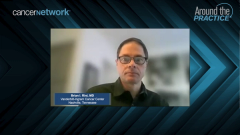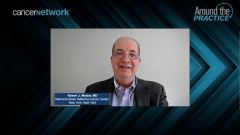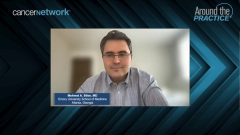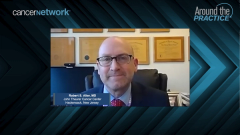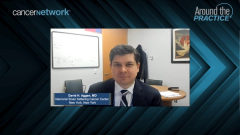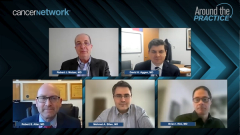
Patient Profile 3: RCC Treated With Adjuvant Pembrolizumab Postnephrectomy
Expert panelists review a clinical scenario of renal cell carcinoma managed with adjuvant pembrolizumab postnephrectomy based on results of the KEYNOTE-564 trial.
Episodes in this series

Transcript:
Robert J. Motzer, MD: Let’s move on to the next case and discussion, which will be presented by Dr Alter.
Robert S. Alter, MD: This is a delightful 82-year-old woman who presents to me postoperatively. Her history dates back. She has some hypothyroidism; a restless leg syndrome that her husband complains about more than she complains about; osteoporosis, and a list of medications she takes for it; a remote smoking history; an aggressive family history of diseases, which led to her decision about how to consider taking therapy; leukemia, GBM [glioblastoma]; and breast cancer.… She had an episode of painful…UTI [urinary tract infection] and an episode of hematuria. Based on the coding of her husband, she presented to the emergency department because it happened to be on the weekend. Otherwise, she would have gone to her primary care physician.
I did not offer her a chemistry panel, which was perfect, as was her LDH [lactate dehydrogenase]. A CT scan in the abdomen and pelvis, because of persistent gross hematuria, revealed a 6.6-cm mass rising from her lateral aspect of the mid to superior portion of her left kidney. The mass was partially exophytic anteriorly, with a possible infiltration of the renal parenchyma. Based on the scan, there was no concern about the vascular invasion, and there was no evidence of adenopathy. A CT on the chest reveals 2 small pulmonary nodules. We did track back a CT scan taken several years ago that revealed these nodules were similar and unchanged with new nodules or adenopathy seen.
She went to laparoscopic robot-assisted left nephrectomy. She had no complications postoperatively. Pathology reveals 4.5-by-3.0-by-3.0-cm clear cell renal cell carcinoma and nuclear grade 3 or 4. There was a large vessel invasion present. The tumor didn’t extend into the uveal sinus fat. The margins were clear with regard to the higher vessels and ureter. Four resected lymph nodes were removed, and all were negative for carcinoma. Margins were negative.
Based on the vascular invasion, as well as the renal sinus invasion, she had T3 disease. We had a discussion about the role for adjuvant therapy. This woman presented in July or August. The KEYNOTE-564 information had already been presented. It was a very hot topic. I talked to her about the data. As we try to deal with our patients, we don’t tell them what to do. We educate them and offer them advice in regard to how we can advocate on their behalf.
Initially, she opted not to receive therapy. We did follow up with a phone call, just as our nurse navigator does with all our new patients. She reflected back and thought about her family history and how none of the family members who passed away from diseases of malignancies were ever given an opportunity to prevent their cancer from coming back. After a discussion of active surveillance vs initiation of adjuvant therapy, she opted to receive adjuvant therapy. She came into in the office and received her fifth cycle of pembrolizumab. She has had no toxicity. I spoke to her yesterday to remind her about her appointment, and she feels fine.
Robert J. Motzer, MD: All right. Thanks very much. The big news for RCC in 2021 was the results of the KEYNOTE-564 trial and its FDA approval in December. David, can you tell us a little about that study, the design of the study, and the results that led to the approval?
David H. Aggen, MD: KEYNOTE-564 was a randomized phase 3 trial evaluating pembrolizumab or placebo for patients deemed higher risk for recurrent disease. Patients receive pembrolizumab every 3 weeks to complete a year of therapy or placebo. At ASCO GU [American Society of Clinical Oncology Genitourinary Cancers Symposium], they presented the 30-month follow-up. In the entire study population, the disease-free survival [DFS] rate at 2 years was 78.3% with pembrolizumab vs 67.3% with placebo. That was a statistically significant difference in disease-free survival. The OS [overall survival] data are still maturing, but they appear to be trending toward a potential OS benefit.
For our patients, a DFS benefit is meaningful, perhaps even more than it is to us. We want to see an OS benefit. But for a patient to say that they’re disease-free and that they can do something that will improve the chances of being disease-free by 10%, with an adverse-effect profile that’s consistent with what we see with PD-1 monotherapy in the metastatic setting, many patients are interested in pursuing this. There’s a lot of enthusiasm from patients to get adjuvant immunotherapy. It will be interesting to see, as these data mature, if this is driven by patients who are M1 NED [no evidence of disease] or if this is something that’s going to continue to extend across all subgroups.
Transcript edited for clarity.
Newsletter
Stay up to date on recent advances in the multidisciplinary approach to cancer.


